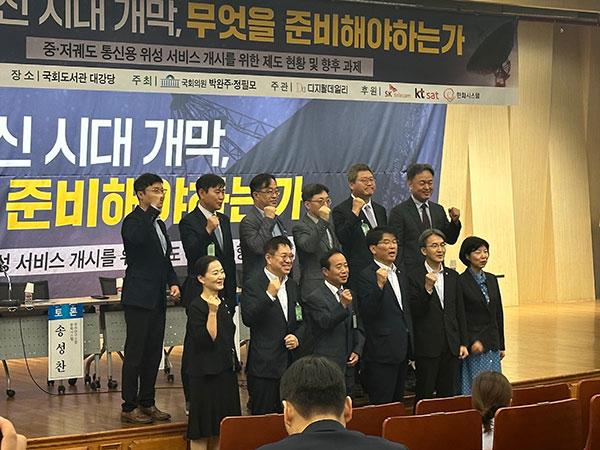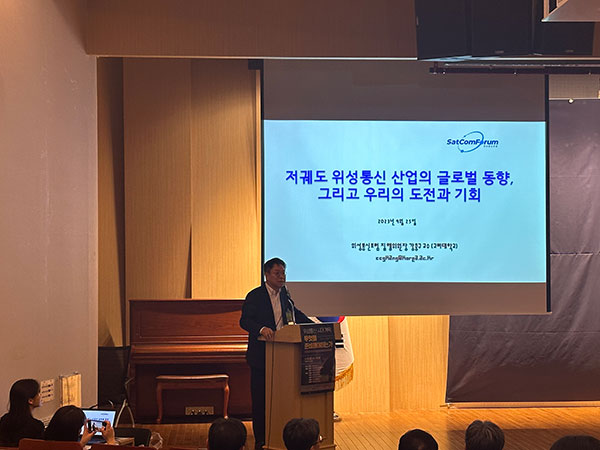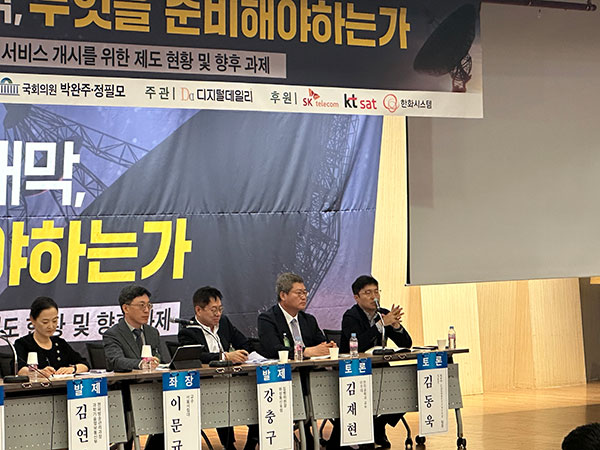25일 국회 대강당에서 박완주 위원, 정필모 위원 주최 ‘위성통신 시대 개막, 무엇을 준비해야하는가’를 주제로 중·저궤도 통신용 위성 서비스 개시를 위한 제도 현황을 공유하고, 향후 과제를 논의하는 장이 열렸다. 위성통신이 차세대 네트워크의 핵심 인프라로 주목받는 가운데, 우리나라가 위성통신 산업을 선도하기 위해 국가적 차원에서의 독자적인 저궤도 위성 인프라 구축 전략이 시급하다는 전문가의 의견이 모아졌다.
30년 2161억불 전망…저궤도 위성통신 비중 ‘67%’
韓 주도 민군 겸용 독자 위성망 구축 강조
SKT, 이동통신-위성통신 결합 ‘보완제 역할’
위성통신이 차세대 네트워크의 핵심 인프라로 주목받는 가운데, 우리나라가 위성통신 산업을 선도하기 위해 국가적 차원에서의 독자적인 저궤도 위성 인프라 구축 전략이 시급하다는 전문가의 의견이 모아졌다.
25일 국회 대강당에서 박완주 위원, 정필모 위원 주최 ‘위성통신 시대 개막, 무엇을 준비해야하는가’를 주제로 중·저궤도 통신용 위성 서비스 개시를 위한 제도 현황을 공유하고, 향후 과제를 논의하는 장이 열렸다.
과기부는 지난 18일 독자 저궤도 위성통신망 확보 타당성 검토를 위한 ‘K-LEO통신 얼라이언스’ 구성 추진을 위성 통신 활성화 전략을 발표한 바 있다. 이번 토론회는 정부 발표 이후 처음 개최된 토론회로, SKT, KT SAT, 한화시스템, ETRI, 아주대 등 산학연이 모두 참여했다.
박완주 국회의원은 환영사에서 “주요 해외 기업들에서부터 촉발된 저궤도 위성 시대는 이미 시작됐다”며, “R&D 예산이 줄어들었지만 지금 예타로 투자하지 않으면 10년이 더 뒤처지기 때문에 함께 뜻을 모아달라”고 당부했다.
저궤도 위성은 고도 300~1,500km에서 활동하는 위성으로, 도서·산간 지역처럼 지상망 구축이 어려운 경우, 이를 보완할 수 있어 6G 시대의 핵심 인프라로 떠올랐다. 특히 기존 정지궤도와 달리 저궤도 위성통신은 전송속도와 지연시간이 LTE에 상응한다는 이점이 있다. 세계 주요국은 이미 독자 위성망을 구축하고 있으며, 스페이스X, 원웹, 아마존과 같은 글로벌 기업의 주도로 시장이 급속히 성장하고 있다.
스페이스X의 스타링크는 전세계 45개국 서비스 중이며, 2024년 글로벌 서비스를 목표하고 있다. 최근 비싼 안테나 가격을 해결해 원가를 낮춤으로써 흑자 전환을 발표한 바 있다. 한화시스템이 7%의 지분을 확보하고 있는 원웹도 2023년 하반기 글로벌 게이트웨이 구축을 통해 서비스를 목표하고 있다. 아마존의 자회사 퀴퍼 시스템(Kuiper Systems)도 12조 이상 투자가 예상되며, 2025년 이후 상용화가 예상되고 있다.
과기부 김연진 전파방송관리과장에 따르면, 글로벌 위성통신 시장은 2030년 2,161억불까지 성장하고, 이 중 저궤도 위성통신의 비중은 67%에 달할 전망이다.
그러나 우리나라는 과기부 예비타당성 대상 사업에서도 연이어 탈락하며 위성통신에 대한 투자가 저조해왔다.
김연진 과장은 “타국의 위성을 사용할 경우, 통신 주권과 안보 측면에서 우려가 된다”며, “이동통신 강국인 우리나라도 독자 기술 개발을 서둘러야 한다”고 주장했다.
위성통신포럼 강충구 집행위원장은 저궤도 위성통신 산업 동향 발표에서 우리나라도 기회가 있다고 말했다. 현재 글로벌 기업들의 기술은 표준 기술이 아니며, 우리나라도 표준화에는 노력을 기울이고 있고 앞으로의 기술 확보가 중요하다는 설명이다.
강 집행위원장은 “우리나라는 K-LEO 얼라이언스를 넘어 한국 주도의 민군 겸용 독자 위성망을 구축함으로써 글로벌 이니셔티브를 달성해야 한다”며, “K-컬처(Culture), 즉 한국 문화의 입지가 향후 위성통신 산업에 있어서도 강력한 인프라로 작용할 것”이라고 주장했다.
또한 이를 위해 “위성통신 사업은 자본, 기술력, 고객 기반이 모두 요구되는 만큼 국가가 하나의 기업처럼(corporate-K) 전략을 수립해서 산학연이 함께 연합해야 한다”고 주장했다.
이어 진행된 토론에는 KT SAT, 한화시스템, SKT와 ETRI, 아주대가 참여했다.
KT SAT 채종대 기술총괄본부장은 위성통신 서비스의 연계를 강조했다. 채 본부장은 “위성통신 사업은 기술 개발뿐만 아니라 서비스 분야의 정책이 갖춰져야 한다”고 강조하며, 500조 예산이 들 것으로 예상되는 가운데, 국내 LEO 사업자에 대한 국가적 보호 육성 방안도 촉구했다.
KT SAT은 위성망도 지상망처럼 ‘멀티 오빗 하이브리드’로 발전하며 투자 대비 효용성을 고려해 중궤도 시스템에도 투자하고 있다.
한편 한화시스템 우주연구소 연구소장 송성찬 상무는 글로벌 사업자와 조화로운 운영을 주장했다. 한화시스템은 위성 엔드투엔드 솔루션을 확보하며 원웹 기반으로 7월 기간통신사업자 등록을 마친 후, 24시간 저궤도 위성통신 네트워크 서비스 진출 계획 중에 있다.
송 상무는 “24시간 독자적으로 하기 위해 한시적으로 기존 글로벌 사업자들의 기술을 적절히 활용해 해외 성능 위성을 검증해야 한다”고 말했다. 외산 종속성에 대한 우려에는 “스타링크와 다르게 원웹은 B2B, B2G 서비스기 때문에 협조가 원활해 종속성 탈피가 가능할 것”이라고 덧붙였다.
SKT 뉴커넥티비티 김동욱 팀장은 이동통신사업자 입장에서, 이동통신 역량으로 저궤도 위성통신 주도권 확보에 대한 자신감을 드러냈다. 김 팀장은 “17번까지 위성 재사용이 가능한 기술로 비용이 낮아진 현재 시점 위성통신 기술 개발이 촉구된다”며, “기존 이동통신과 위성통신을 결합하여 제공하는 방향으로 나아가고 있다”고 말했다. 즉 기존 이동통신을 대체하기보다는 보완재 형식으로 음영 지역이 없도록 서비스를 제공한다는 입장이다.
SKT도 글로벌 사업자와의 적극적인 협력을 필요로 하고, 이를 기반으로 선제적으로 국내에 맞는 기술과 서비스를 발굴한다는 입장이다. 또한 스마트폰 직접 통신을 위해 미국 등에서 주파수 체계 마련이 진행되는 만큼, 우리나라도 서비스 개시를 위한 준비가 시급하다고 주장했다.
ETRI 이문식 위성통신연구본부장은 민군 겸용 기반 6G 저궤도 위성통신 추진을 주장했다. 한반도에는 24시간 서비스를 위해 200개의 위성 수가 필요하고, 국가 주도로 민군 공통 요구사항을 충족하자는 설명이다.
아주대 김재현 전자공학과 교수는 우주 인재 양성을 촉구하고, 대통령 산하 위성 특별위원회 구성을 언급했다. “정부 주도로 위성산업 생태계를 구성해야 하며, 우주 통신 학과 개설을 늘리고 학생들이 현업으로 연계가 가능한 프로그램도 필요하다”고 덧붙였다.
과기부 김연진 과장은 “주파수 공유 운영 조건을 마련하고, 사업자에게 준수 의무를 부과하는 정책을 검토하고 있으며, 어떤 주파수에 대한 독점이 없도록 정부가 관리할 것”이며 “게이트웨이 수요가 확대되기 앞서 설비 구축 기준 등을 마련하겠다”고 덧붙였다.


